#Sputnikmusic
Text


If you listen to Amused To Death very carefully through the speakers (this will not work in headphones, there must be speakers), if you sit in the middle and immerse yourself in the sound, you will hear all sorts of unusual things. For example, something will "appear" on the right — and you will be amazed: "Wow! How was it done?"...If you're the kind of person who really cares about such audio experiments, you should listen to it one day. But you need to get a really good amplifier and very good speakers. Then sit right in the middle, close your eyes and listen at least once from beginning to end.
ROGER WATERS– Amused To Death (1992) 🇬🇧

The third solo studio album by Roger Waters, the former leader of the Pink Floyd band (except for his soundtracks for the films "The Body" (1970) and "When the Wind Blows" (1986), released in 1992. The album reached the 8th place in the UK charts, rose to the 21st place in the USA, and took the highest position in New Zealand — the 6th place. According to Allmusic, Blender, Entertainment Weekly and Sputnikmusic reviewers, this album is the best in Waters' solo career.
In October 1987, Waters, along with his band The Bleeding Heart Band, did several recording sessions at Compass Point Studios in Nassau, Bahamas. Work on the album continued in London in 1988 and 1989. The album was originally supposed to be released in 1989, but Waters felt that it was not ready yet. At first, he planned to release the album as a sequel to his previous work, "Radio K.A.O.S.", but, "catching fire" with the "television concept", he cooled down to the original idea.

The album was written for a total of 18 months at 10 different studios. To get an optimal result, the order of the songs was changed up to seven times. The only studio material from the 1987 sessions was the drum part in the song "Perfect Sense". The last song recorded for the album was "It's A Miracle". In this composition, the musician sarcastically speaks about the British composer Andrew Lloyd Webber, whom he accused of plagiarism: "... then the piano lid slams shut and breaks his fucking fingers. It's a miracle." The final version replaced a faster version of this song with bassist Flea from the Red Hot Chili Peppers.
Patrick Leonard, who had previously worked with Madonna, Elton John and Pink Floyd on the album A Momentary Lapse of Reason (as keyboardist and co-writer), was chosen to co-produce the album along with Waters himself. A great success for Waters was the involvement of Jeff Beck, the most famous guitarist, former member of The Yardbirds and a successful solo artist, to work on the album. Beck participated in the recording of 7 songs of the album.

The main idea of the album was inspired by the Stanley Kubrick film "2001 Space Odyssey" (English "2001: A Space Odyssey"), specifically, shots in which a monkey squeezes a bone in his hand, smashes it against a rock and suddenly realizes that it can be used as a weapon. Waters used by analogy the image of a gorilla watching TV (she is also depicted on the cover) and randomly switching channels in search of something interesting. The main idea expressed by Waters in this album is a view of television as an independent force that has power over the minds of many people.
"When television becomes commercial and turns into a source of profit, it makes our lives banal and inhumane." (c)
The name of the album was coined based on Neil Postman's book "Amused to Death" (English: "Amusing Ourselves to Death"), written in 1986 and devoted to the problems of the relationship between the media and the authorities.
Rog is the author of most of Floyd's ideas. And if he could create brilliant things for PF, then why not create a brilliant solo album? So, he's in front of us!

Mick Box (guitarist Uriah Heep):
I spent many days and nights comprehending the depth of this CD, but I didn't sit with my head in my hands and delve into the essence, but just listened. At the same time, I can't listen to it from the middle or some individual tracks, only in its entirety.
#Everything you need to know about Rock📌
#roger waters#Spotify#progressive rock#psychedelic rock#art rock#pink floyd#The Bleeding Heart Band#music#my music#music love#musica#history music#rock music#spotify#rock#rock photography#my spotify#everything you need to know about rock
4 notes
·
View notes
Note
he got sued for “do not open before Christmas?”
i actually dont know if the band filed because it seems like it was just a public accusation but a band called knives out said they plagiarized a tshirt of the bands that said “the ribbon on my wrist says do not open before christmas.”
personally i doubt this was deliberate plagiarism nor is the line that original lol
10 notes
·
View notes
Text

Ppl talk about rym but sputnikmusic is where the real music appreciators reside......
#i love luci bc they wrote an incredibly indulgent 4.5/5 review for Baths' Romaplasm#an album practically no one cares about#except Real Music Appreciators
0 notes
Text
Kaospilot (2001-2005)

Kaospilot was an Emoviolence, Anarchist-Skramz, and Noise band from Oslo, Norway. Formed from 2001 to 2005, the quintet band included Kristoffer Rødseth (Vocals), Øystein Rånes (Guitar), Petter Ringstad (guitar), Anders Simonsen (Bass), and Mads Hornsletten (Drums).
Kaospilot mainly focused on questioning systematic ways of thinking and behaving that are taken for granted but should be reconsidered. Although Kaospilot sang about philosophy and several political subjects, they didn't see themselves as a political or revolutionary band. They were based on certain paradigms from certain philosophers to help make their texts more understandable. Furthermore, Kristoffer Rødseth wrote about subjects that engaged him, such as the 'systematic and brutal repression by the American defense institution School of the Americas,' 'Latin American liberation groups fighting for human rights and freedom,' and other topics like Human Trafficking and the capitalism of Antidepressants. They tried to make their music more challenging and push the boundaries as far as possible.
Although Kaospilot shares the name with the Danish School, Kaospiloterne, they have nothing to do with the school and were unaware of it when they named their band.
With the following they had, they toured in Europe, the USA, and Japan. Kaospilot only performed at DIY independent places with close contact with the audience.
There are no articles or interviews where the band states their breakup, but following the breakup, both Kristoffer Rødseth and Anders Simonsen formed a new band in 2010 called Soul Mountain to explore new musical fields.
Kaospilot produced 2 albums, 1 single, 2 splits, and 1 compilation. They debuted with their first single, 'For Your Safety' (2001). Subsequently, a split with Neil Perry (2002), their first album titled 'Kaospilot' (2003), a split with Van Johnson (2004), and their final album, 'Shadows' (recorded in 2005, released in 2009).
You can still listen to Kaospilot on Spotify (Kaospilot, Shadows).
Kaospilot - Process is set (Performed at Chop Fest) (via Youtube)
Source:
0 notes
Text

I've always loved the album artwork for this Bersarin Quartett album, but I love the music even more. It is one of my all time favourite records. If you don't know Bersarin Quartett, check them (him) out. His real name is Thomas Bücker.
The music is hard to classify (just as I like it)... is it modern orchestral... is it ambient electronic... like soundtracks to unmade films.... you be the judge.
Their last album was back in 2019, and this particular album is from 2010, but to my delight, I just realised there is a new Bersarin Quartett single on Spotify, so I hope (really hope) a complete new album will follow.
Some accolades about this album from BandCamp:
"With some albums, you realize within a few seconds that here you have come across something really special. It is music that touches you straight away. Music that is important, that has a story to tell – and that manages to do so without even a single line of lyrics. Wonderful orchestral pieces full of longing and melancholy. It is that certain kind of melancholy that seizes you when you are moved while following the final credits of an emotionally touching movie, remembering special moments that have faded in the course of many years and linger hazily in your memory, when you are somewhat wistfully contemplating old, worn photographs from days passed by … not a feeling of failure or hopelessness, but a bittersweet reflection."
'It's rare that I'm able to give an album my fullest recommendation without trepidation.' (The Silent Ballett)
'An incredible release in the electronica world, but one that fans of many other genres will enjoy.' (SputnikMusic).
0 notes
Text
#review#the archer#you can tell this is a honest review when it says that the lowest moments are BAD DISEASE and Can't Help Myself
0 notes
Text
For all the loved-up, queerbaiting opener “Lavender Haze” grounds the album in a languid version of the here-and-now, the majority of its tracks come off as revised memoirs of episodes already well-chronicled, replete with recycled melodies, tepid choruses and laboured intertexts galore. For lack of a better word, it’s dull.
0 notes
Photo

Im dead
7 notes
·
View notes
Note
seth you’ve mentioned being rly into music. how would one get to know music. i feel i’ve not so far, idk, explored what’s out there. like i’ve listened to throbbing gristle and townes van zandt and the smashing pumpkins but so has everybody. not turning music into like a scoring thing just asking. i don’t want to go on /mu/ bc that’s a 4chan thing. i don’t have any musical training. sorry if this is rude
When I was first getting to know music - and tbh I would say I am kind of a picky listener, and not necessarily in a good way [1] - I mined through Wikipedia and AllMusic for artists to listen to, and made a big list to work through, because I am a lunatic. (I have maintained this list since like 8th grade and have never whittled it down to less than a couple pages, lol.) Often this was guided by genre. So like, for example, one Christmas I got the “Encyclopedia of Punk,” and I spent ages pouring through that, looking up the bands they talked about on Wikipedia and AllMusic to see what was well-received critically or by fans, finding those albums on YouTube, hunting for torrents, etc. I did the same thing when I was getting into hip-hop and metal.
So I think, at the very least, picking either a genre you’re interested in hearing more about, or a band/artist that you like, and just digging through the Internet for what comes up is a good strategy.
Asking people what they have been listening to lately is also usually an interesting conversational topic ime (though sometimes it ends up being a podcast convo, which is also fine). A lot of my friends through high school and college were very into similar music as myself, but of course had their own experiences and interests, which gave me access to new stuff I hadn’t heard before. [2]
As I got older and more attentive to music that was currently being released, I got more reliant on the “review” format to introduce me to things to listen to - I frequented music sites, primarily SputnikMusic, or watched music YouTubers. On that latter front, Fantano is reliable at least for recommendations or things to pay attention to, but I would also recommend the channel “deep cuts,” which explores a lot of artist’s discographies in great detail.
Sputnik is cool because they have all these charts of like the best rated albums of X year, and you can narrow that by genre too. Also each artist’s page has a little “Similar Artists” feature, so like you can essentially go on a Wiki Walk from artist to artist to form all the connections. Just don’t participate in the forums/comments cause they suck lol, it’s a little /mu/-lite. Alternatively BestEverAlbums is pretty cool and has a similar “chart” feature of well-respected records, though it’s unfortunate that they don’t have a genre filter! [3]
Hope all this helps! Feel free to message me more if you wanna, but I will say that I don’t think you should feel bad for listening to those artists, not only because nobody should feel bad for what music they like (except Skrewdriver fans, and I guess Ariel Pink fans now), but also because I feel like you may be overestimating how many people listen to Throbbing Gristle and Townes van Zandt.
[1] I don’t really listen to classical, post-rock, ambient, or most instrumental music; there’s a comparatively narrow slice of metal that I actually like; I only really listen to a few key artists from genres like reggae (I prefer ska) or folk. Like you said, it’s good not to treat expanding your music tastes as a “scoring” thing, so much as a way to expand your palette, think about why you like the things you like, enjoy new emotional and intellectual experiences, etc.
[2] It should be noted that now that I’m in law school, nobody has good taste.
[3] I know a lot of people have used RateYourMusic but I never did, so I cannot speak to that.
13 notes
·
View notes
Text
Lover Reviews Masterpost
Rolling Stone: Taylor Swift Reaches For New Heights of Personal and Musical Liberation on ‘Lover’
Billboard: Taylor Swift's 'Lover' is Free-Spirited, Full of Passion & A Snapshot That Will Endure
Time Magazine: On Lover, Taylor Swift Lays Down Her Armor
Variety: Album Review: Taylor Swift’s ‘Lover’
The Independent: Taylor Swift, Lover review: The sound of an artist excited to be earnest again
The Guardian: Taylor Swift: Lover review – pop dominator wears her heart on her sleeve
Vanity Fair: Taylor Swift’s Lover Could Hold the Key to Pop Music’s Survival
Forbes: First Listen: Taylor Swift's 'Lover' Is A Masterful, Heartfelt Pop Spectacle
Mashable: Taylor Swift's 'Lover' is a dreamy and thrilling adventure
The Atlantic: Taylor Swift Finds Her Faith on Lover
AllMusic: AllMusic Review by Stephen Thomas Erlewine
The Telegraph: Taylor Swift, Lover, review: zippy, feminist electropop about young love – and watching rugby down the pub
NME: Taylor Swift – ‘Lover’ review
USA Today: Taylor Swift is a kid again on 'Lover,' a big, messy embrace of a new album
The Ringer: Taylor Swift’s ‘Lover’ Is a Perfect Snapshot of Her Life—and Possibly Her Best Pop Album
Stereogum: Premature Evaluation: Taylor Swift Lover
CoS: Taylor Swift Takes the High Road on the More Mature Lover
AV Club: Taylor Swift is done proving herself on the resonant Lover
Entertainment Weekly: Lover is pure Taylor Swift, at her most content and confident
Exclaim: Taylor Swift finally sounds happy
Boston Globe: On ‘Lover,’ Taylor Swift shuns drama for satisfying pop
LA Times: Taylor Swift’s ‘Lover’ courts — gasp! — adults with grown-up emotional complexity
NY Times: Taylor Swift Emerges From the Darkness Unbroken on ‘Lover’
Pitchfork: On her seventh album, Taylor Swift is a little wiser and a lot more in love
No Ripcord: Lover is a plethora of things: a Taylor Swift genre sampler, an argument that Jack Antonoff is her best collaborator, a continuation of her problem with lead singles, and a collection of great synthpop songs, but the best part of it is that Taylor seems like she’s never been better
Spin: Taylor Swift’s Lover Shines in Its Quietest Moments
Clash Music: An album that only comes into her own when she is truly herself...
Slant Magazine: Taylor Swift’s Lover Course Corrects in Multiple Directions
Sputnikmusic: Listeners are always equidistant from good and bad on Taylor Swift's seventh album
The Guardian: Taylor Swift: Lover review – a return to past glories
Paste Magazine: We Don’t Have Taste (or brains).
#nobody asked but here it is#so far#mainly for my organizational needs#taylor swift#lover reviews#masterpost
1K notes
·
View notes
Photo



𝐋𝐎𝐒𝐓 𝐒𝐎𝐔𝐋 foi o segundo álbum de estúdio do Limenony e o primeiro sob a gravadora Red Lightning Records. Com o som muito mais pesado que seus lançamentos de sucesso, o projeto quase foi impedido de acontecer por não ser exatamente o tipo de música que a empresa desejava para banda, sendo necessárias muitas negociações e mudanças para que saísse do papel, mas ainda sem tanto investimento em marketing como planejado inicialmente por ainda acreditarem ser uma furada. Infelizmente, a agência por trás do grupo estava correta quanto a receptividade do público mainstream que gostariam de alcançar e o álbum foi visto como uma enorme quebra de expectativas aos recentes fãs da banda, apesar dos mais antigos terem recebido muito bem as canções tão íntimas sobre batalhas internas, ansiedade e depressão.
O álbum recebeu críticas polarizadas dos críticos. Alguns elogiando a perfomance de post-hardcore e rock alternativo da banda e a narrativa assumida nas canções, enquanto outros foram menos interessados no estilo e criticaram a escolha, que se destoou bastante dos seus hits. Sputnikmusic descreveu o álbum como “uma experiência genuína da raiva proveniente da solidão e da falta de esperanças no mundo moderno”, pontuando-o com 4 de 5 estrelas. Todavia, uma crítica menos positiva da Drowned In Sound intitulou o álbum como “a maior decepção sonora da geração Tik-Tok” e afirmou que “a banda pecou ao não aprender que o gênero musical deles é outro”, avaliando-o com 4 de 10.
𝐒𝐢𝐧𝐠𝐥𝐞𝐬
Stranger In The Mirror e Crash And Burn
𝐓𝐫𝐚𝐜𝐤𝐥𝐢𝐬𝐭
𝟏. 𝐋𝐨𝐬𝐭 — “Lost inside my mind / I'm falling farther and farther behind / It's getting harder and harder to fight / I can't keep running away / Running away / From me.”
𝟐. 𝐒𝐢𝐧𝐤 𝐈𝐧𝐭𝐨 𝐍𝐨𝐭𝐡𝐢𝐧𝐠 — “How can you take every moment / And disown it / How can you sing / In an ocean of distortion / I can promise you nothing / My bones are so weak / I'm praying for failure / Who's praying for me / Here I sink, here I sink into nothing.”
𝟑. 𝐒𝐭𝐫𝐚𝐧𝐠𝐞𝐫 𝐈𝐧 𝐓𝐡𝐞 𝐌𝐢𝐫𝐫𝐨𝐫 — “I told myself I wouldn't become this / Active in the problems I so tried to avoid / An outline of the person that I once was / A shadow moving closer / I just can't seem to find the answer.”
𝟒. 𝐋𝐨𝐰 — “Pick me up from the floor / I'm reborn 'cause I'm done / Pretending I just need to be brave / Tell me now, come around / If the sky is falling / Tell me something / I wanna hear / I need it now.”
𝟓. 𝐖𝐡𝐚𝐭'𝐬 𝐋𝐞𝐟𝐭 𝐈𝐧𝐬𝐢𝐝𝐞 — “Face down / I'm somewhere far away / And I'm lost now / Cause you just see me for all my mistakes / I was never good enough you know / You never had to say the words / It was right on your face / You just pushed me away / And every time heard that you're a swing / I remember wishing I was anywhere else.”
𝟔. 𝐂𝐫𝐚𝐬𝐡 𝐀𝐧𝐝 𝐁𝐮𝐫𝐧 — “Why can't we talk about it? / You're always walkin' out / You make it worse / You never learn / I don't know how to fake it / When we're disintegrating / No return / We'll crash and burn.”
𝟕. 𝐄𝐦𝐩𝐭𝐲 𝐑𝐨𝐨𝐦 — "I’m feeling like an empty room / And everyone can see right through / Don't know what's my aim, don't know where's my flame / It all makes me feel so blue / I’m just a bad clone of myself / And it's so sad that I’m aware / I’m wasting my life away.”
𝟖. 𝐖𝐨𝐫𝐥𝐝 𝐀𝐰𝐚𝐲 — “My life is what I make it / I choose to rise and take it from your hands / This is not my punishment / This is my catalyst for growth / I know I will survive this / I'll be the strongest person I know.”
𝟗. 𝐀𝐫𝐞 𝐘𝐨𝐮 𝐑𝐞𝐚𝐝𝐲 𝐓𝐨 𝐋𝐢𝐯𝐞? — “Sometimes it can get real hard / Spending most of those days in the dark / Life feels like it's pulling apart from the seams / And it seems like there's nothing / So what we gonna do with all that pain? / And what we gonna do with this path we have made? / And it's easy just to walk away / And wait it out, but I can't wait it out not anymore.”
4 notes
·
View notes
Note
Why would u id as a commie when places North Korea exists lol. Are u that dumb or are u just being performative on tumblr to be relatable
Rabies is the fifth studio album by Skinny Puppy. It was released on November 21, 1989 through Nettwerk. The album notably features Ministry frontman Al Jourgensen (credited as Alien Jourgensen) who performed electric guitar and vocals on several songs. The album spawned two singles, "Tin Omen" and "Worlock", the latter of which becoming one of the band's most recognizable songs. The cover art was made by longtime Skinny Puppy collaborator Steven R. Gilmore. In 1993 the CD edition was reissued by Nettwerk to correct mastering errors in the original release.[1]
Rabies was a commercial success for the band, but received mixed reviews from critics upon release, several of whom drew parallels between the record and Ministry's style, both favorably and unfavorably. A joint tour with Ministry, KMFDM, and My Life with the Thrill Kill Kult, dubbed The Mutants of Rock Tour, was planned but ultimately cancelled when Skinny Puppy ended its commitment to the project.
Recording and production[edit]
Most of the band's previous albums had been mixed and produced by the group's "fourth member" Dave "Rave" Ogilvie. For Rabies, lead singer/songwriter Nivek Ogre brought in friend and Ministry frontman, Al Jourgensen. Ogre had met Jourgensen during the recording of the PTP song "Show Me Your Spine" in 1987. Ogre later toured with Ministry (Ogre can be seen and heard on the In Case You Didn't Feel Like Showing Up video and CD) and would also go on to provide vocals for Jourgensen's side project Revolting Cocks.[2][3] The other two members of Skinny Puppy, cEvin Key (drummer) and Dwayne Goettel (keyboardist/synthesist), did not approve of Jourgensen's takeover, creating a "glacial coldness" between the band members.[4][5] A couple years following the release of Rabies, Key mentioned to Alternative Press that he believed Jourgensen's motive for assisting in the album's production was to try and break up Skinny Puppy.[5]
Much of the album had been written before Jourgensen was officially involved, though Key has mentioned that the process was influenced by the notion that Jourgensen might join them in the studio to "jam." The group took into consideration what type of music Jourgensen would be interested in making, thus writing guitar heavy material such as "Tin Omen,"[5] a song which makes reference to the Tiananmen Square protests of 1989.[6] "Fascist Jock Itch," also written with Jourgensen in mind,[5] was inspired by an incident between Ogre and a few skinheads. Ogre states that he had been approached by the skinheads who then proceeded to question him regarding his "loyalty towards communism" (prompted by a small Red star on his pants). Feeling threatened, Ogre pushed one of them away and a short scuffle ensued.[3] Other songs on the album, such as "Worlock" and "Choralone," have been described as being more "pure" to previous Skinny Puppy material.[5] The song "Hexonxonx," a song which criticizes the use of oil (written in the aftermath of the Exxon Valdez oil spill of 1989),[7] has been described as being an exemplary mixture of "twisted humor and Throbbing Gristle-like experimentation", while other entries from the album have been noted for their novel use of sampling.[8]
The song "Worlock" has been played on every tour after its conception. A Roland Harmonizer was used to create the vocoder-effect during the chorus. Samples of the song "Helter Skelter" by the Beatles are mixed with an excerpt of Charles Manson singing the song;[9] the excerpt comes from the 1973 documentary Manson.[10]
Release and promotion[edit]
The original CD release on Nettwerk (and the licensed version on Capitol) was mistakenly mastered with Dolby B noise reduction, which resulted in a muffled sound. In 1993, the album was digitally remastered and re-released on Nettwerk.[1]
Only one promotional video was produced for Rabies. The "Worlock" video was primarily a rhythmically edited string of horror movie clips featuring outtakes and clips from the band's earlier video, "Stairs and Flowers" (from the album Mind: The Perpetual Intercourse). The video, which opens with a "Rated X" graphic, was intended to be a critique of the concept of censorship in America.[3] Many of the movie clips featured in the video were from films made by controversial Italian filmmaker Dario Argento, whose work has a reputation for being heavily censored by US distributors in order to gain "R-Ratings" from the MPAA.[11] For the "Worlock" video Skinny Puppy included footage deleted from the US versions of such Argento films as Deep Red, Suspiria, Tenebrae, Phenomena, and Opera. Other films included in the music video include, The Beyond, Hellbound: Hellraiser II, Bad Taste, Dead and Buried, Luther The Geek, Henry: Portrait of a Serial Killer, From Beyond, Death Warmed Up, Eraserhead and Altered States.
Due to the graphic violence of the horror film clips used in the video, and also copyright violations, "Worlock" was subsequently banned by MTV, and did not receive any television airplay.[12] In 1992, Skinny Puppy released a compilation of their music videos, but "Worlock" was noticeably absent. According to Nettwerk, the video was omitted partially due to copyright problems and also because of concern the video would be banned by other countries which might find the video's content obscene.[citation needed] However, in recent years the video has been widely bootlegged among fans on the Internet. "Backing" videos for "Tin Omen" and "Choralone" were produced for the Too Dark Park tour in 1990, and have also been spread on the Internet.
A limited run of promotional mechanical pencils were made and sent to college (and possibly other) radio stations along with the album. Shaped like a syringe the pencils were white with black lettering "SKINNY [PUPPY]" and white on black lettering "RABIES". They were approximately 4 inches in length.
The Mutants of Rock Tour, which was to include a quadruple bill including Skinny Puppy, Ministry, KMFDM, and My Life with the Thrill Kill Kult, was to begin on December 27, 1989. However, according to Key, the tour was called off when Skinny Puppy collectively decided to pull out, citing concerns regarding the band's then uncertain situation. Key suggested a potential line of shows for the summer of 1990, but expressed little faith in any tour supporting Rabies ever happening.[13] Ogre ultimately joined Ministry's tour for The Mind Is a Terrible Thing to Taste.[14]
Critical reception
Since the album's release, reception from both critics and fans has been mixed. Alternative Press said Rabies was more of a Skinny Puppy/Ministry hybrid and was not representative of the group's best work.[5]
Tim DiGravina from Allmusic stated that Rabies was a solid release, even though he felt the band was not performing "at their peak". He goes on to praise the album's implementation of movie dialogue, particularly commending its use in the songs "Worlock", "Tin Omen", and "Rivers". DiGravina was, however, less impressed by Jourgensen's contributions, asserting that the same qualities which made The Mind Is a Terrible Thing to Taste a good album were not suitable for Rabies.[8] Trey Spencer from Sputnikmusic was less favorable, calling the record one of the group's "low points". He was critical of the album's use of simple (and sometimes "formless") song structures and claimed that the sampling brought nothing meaningful to the table. Spencer was more receptive to the song "Worlock", calling it the band's "defining moment", but concludes by saying that "the rest of the album consists of two good Industrial Metal songs, three average songs, and five songs that aren’t worth wasting your time on".[18]
Beth Fertig of The Boston Globe panned the album as "just another festering collection of noise", but pointed out the use of humor on songs such as "Fascist Jock Itch" as a positive element of the band's music.[15] Daniel Lukes of Kerrang! said that despite a "handful of undeniably classic tracks", the album comes across more as a collection of "Ministry B-sides" than a typical Skinny Puppy record.[16]
In a positive review from the Los Angeles Times, writers Jonathan Gold and David Kendrick list Rabies as an essential industrial album, calling it a "slightly atypical" offering that "also rocks a little harder".[17] This sentiment was echoed by CMJ's Brad Filicky, who called the album "a masterpiece of the industrial genre".[21] Jean Carey of the Tampa Bay Times praised the album, calling attention to the use of sampling, the song "Worlock", and Ogre's vocal work, which was compared to a "crazed Jimmy Durante". Carey concluded by saying that "Skinny Puppy's willingness to experiment and change makes [Rabies] well worth a listen".[19] Mark Jenkins of the Washington Post thought the album was less theatrical than their previous efforts, but concluded that the album's "groove is as solid as any the Puppy has ever fetched".[20]
Personnel[edit]
Nivek Ogre (vocals)
cEvin Key (production, engineering, mixing, various instruments)
Dwayne Goettel (production, engineering, mixing, various instruments)
Dave Ogilvie (production, engineering, mixing, backing vocals)
Al Jourgensen (production, engineering, mixing, guitar, additional vocals)
Greg Reely (additional engineering, special thanks)
Marc Ramaer (additional engineering, mixing)
Ken Marshall (additional engineering)
Cyan Meeks (vocals and lyrics on "Rain")
Keith Auerbach (mixing on "Fascist Jock Itch")
Jeff Newell (mixing on "Fascist Jock Itch")
44 notes
·
View notes
Text
Day 351: Thomas Dybdahl - Fever (Extended Version) (2021)

About 7 years ago a friend of mine from my university days, a Norwegian who studied music (and international relations) and plays in a rock band, with whoom I used to occasionally discussed music (and politics), mentioned Thomas Dybdahl and recommended him as someone worth checking out. I did. But at that point, apart from 1 or 2 songs, I thought he was a little too mellow, too sleepy, too bland. I wasn’t in to soul back then. It’s the same with jazz. It takes time and one has to mature into it. It just didn’t click.
And then I have rediscovered him 6 years later. By then, he has recorded 3 more studio albums. The Great Plains (2017) was a good one, but too country infused to my taste. All These Things (2018) was saturated with ballads. I could appreciate the sonic quality, the technicality of his compositions and his warm vocals, but it was not my cup of tea. On both of the albums I found 2 songs I liked, the more upbeat ones. The rest somehow didn’t hold my interest. I’m a picky listener. I know what I like and what’s not for me almost immediately I hear it.

Thomas Dybdahl is a Norwegian singer-songwriter and multi-instrumentalist, originally from Sandnes (south of Stavanger). He was part of Quadraphonics, who released one album and its sound could be described as a mix of funk, groove, soul and electronic. A bit like Jamiroquai, but less dance-like and bit more soul. In 2003 Dybdahl embarked on a solo career and 17 years later here we are ...
In the spring of 2020 Dybdahl released his 8th album, Fever. And then he finally caught my attention. The album was well received by moth critics and public, the one critical point which was mentioned over and over again, was, that the record was way too short. With 9 songs clocking just under 29 minutes, it really is a bit too short. Either way, it is his first record that I really really love and I can have in on repeat for a whole afternoon and don’t get bored. Last week, exactly a year since the release of Fever, he has released an extended version of the album. He added 5 more songs and in my opinion, this extended one is his best work yet.

It’s a groovy soul guitar driven album, full of lush vibes without any come downs. In comparison to his last album, there are hardly any subdued folksy ballads and the album is overall more mainstream and ore accessible. As Raul Stanciu pointed out, the album harkens heavily to late ‘60s – early ‘70s pop, soul, R’n’B and blues rock music. (2) Compared to his previous records, this album is even more D.I.Y. Dybdahl played virtually all the instruments and tracked almost all vocals. (3) The first 9 songs were released just when the whole went into lockdown for the first time, but with the additional 5 ones recorded during 2020 and added to the extended version there was no other choice. D.I.Y. was the only way to do it at all. It was then mixed and co-produced by Håvard Rosenberg.
The opening track 45 is a catchy song reflecting on life crisis and feelings of failing and not living up to ones potential. Hard Liquor is one of the 5 songs that were added to the 2021 extended edition of the album and it already reflects the bizarre life we have been living in the past 12 months of lockdowns and restrictions, trying to get by by all kinds of means, even resorting to booze to ease the tension and pain occasionally. Both songs are uplifting, breezy and downright infectious.
Fever is a sensual ballad and I don’t think I need to describe or analyze it any more. Just give it a listen and use your own imagination.
The track On My Way to California is an intimate ballad that would fit well to any of his last 3 albums. It is crowned by dusty guitar solos and groovy bass notes, sweet croons and falsettos. It’s one of the best songs on the album. (2)

Happy Thursday, relax and enjoy.
Album highlights:
- 45
- Fever
- Hard Liquer
- On My Way To California
Playlist:
https://1url.cz/nKtT9
Links and references:
- Thomas Dybdahl - Wikipedia
- (1) R. Olsen (25 May 2020), Thomas Dybdal annonserer Cabin Fever: Ufrivillig åpen kalender ble til ny musikk. Musikknyheter.no.
- (2) R. Stanciu (15 March 2020), Thomas Dybdahl: Fever. SputnikMusic.
- (3) T. Jurek (13 March 2020), Thomas Dybdahl: Fever. AllMusic.
1 note
·
View note
Photo

Bob Marley and Wailers
Exodus
*****
Exodus is a reggae album which features a "laid-back" production, that contains a "stoned atmosphere that's simultaneously funky and political" according to Cam, an Emeritus from Sputnikmusic.
Cam described the album's musical style as being "different," noting that Marley's style of reggae was not what was prominent in Jamaica during the time, and that the album's music sounds unlike any reggae that came before its release. Emeritus continued to describe the album's sound as being rooted in the blues and soul, with elements of British Rock with a reggae "façade thrown on top" however Emeritus praised this saying "if Exodus was straight reggae, it probably wouldn't be as good as it is."
Exodus contains elements of pulsating bass beats, pianos and funk along with a "liquid-y bass," drumming and guitars with the inclusion of trumpets in the title track. Unlike previous albums Exodus lyrical content moves away from cryptic story-telling and instead is clearer and more straight forward, the lyrics touch upon themes of change, religious politics and sex. Vocally, Marley provides a minimalist approach, trying not to reach his falsettos.
The album's track listing is split over two halves, the first half features songs of religious politics and opens with Natural Mystic which is a slow tempo "fade up" song, followed by "So Much Things To Say" which was described by the BBC as being "exuberant" and features a reggae-scat. The following two songs Guiltiness and The Heathen explore darker territory, before ending on the album's title track. The second half of the album features songs revolving around sex and keeping faith.
14 notes
·
View notes
Text
Happy Anniversary “Meteora”! (March 25, 2003)❤️

Meteora is the second studio album by American rock band Linkin Park. It was released on March 25, 2003 through Warner Bros. Records, following Reanimation, a collaboration album which featured remixes of songs included on their 2000 debut studio album Hybrid Theory. The album was produced by the band alongside Don Gilmore. The title Meteora is taken from the Greek Orthodox monasteries sharing the same name. Meteora has a similar sound to Hybrid Theory, as described by critics, and the album took almost a year to be recorded. It is the first Linkin Park studio album to feature Dave Farrell after he rejoined the band in 2000.
Meteora debuted at number one on the Billboard 200, selling over 810,000 copies in its first week. Linkin Park released singles from Meteora for over a year, including "Somewhere I Belong", "Faint", "Numb", "From the Inside", and "Breaking the Habit". The song "Lying from You" was released as a promotional single. Meteora received generally positive reviews, although critics noted that the album's musical style was similar to its predecessor Hybrid Theory .
Meteora has sold over 27 million copies worldwide, making it one of the best-selling albums of all time. It is certified 7x Platinum by the Recording Industry Association of America (RIAA). It was ranked number 36 on the Billboard Top 200 Albums of the 2000s. Some songs from the album were remixed with some of Jay-Z's songs for the EP Collision Course (2004). "Session" was nominated for Best Rock Instrumental Performance at the 46th Grammy Awards.
Initial writing for a second album dated back to early 2001, while still touring in support of Hybrid Theory. The band had written around eighty different demos during their Hybrid Theory World Tour and LP Underground Tour, within the span of just eight months. Rough song ideas written then would find its way to the final album; notably the intro for "Somewhere I Belong". Bennington recorded guitar notes for it, but found it too folk rock sounding. However, Shinoda and Joe Hahn reworked it, adding effects to it, and then played it backwards, molding it into something the band was happy with. As explained by Shinoda: "Since I reversed it, it was playing 4-3-2-1. The chord progression was reversed. Then I cut it into four pieces, and I played it 1-2-3-4. And that's why it has that sweeping sound.
In early 2002, after the touring, the writing continued in Mike's home studio, pre-production of the album began there. The band worked in pairs during the writing process, whereas Shinoda was always involved in all the songs. The recording of the songs mainly used Pro Tools, whereas the band used the traditional method of writing, in main studio. In June, pre-production terminated and the band headed for main production. The band finalized Don Gilmore as their producer. When Reanimation was released, the band had started to write the main content. Rob Bourdon spent eight hours a day in the studio for the recording of the album. By August, the band entered NRG Studios as Bennington also began writing songs with the band.
Linkin Park had finished versions of many songs before the actual recording process had begun, but they majorly wrote the finalized songs included in the track list in the studio. By October the drums were finalized and guitar parts were introduced by Brad in the control room of the studio. By the end of October, the bass parts were introduced. Don Gilmore himself being a bass player helped Farrell in his recording. The sampling part by Hahn was introduced just a month before the deadline, thereby Mike finished the recording of "Breaking the Habit" with strings arrangement by David Campbell; the song had been worked on by Shinoda for five or six years. The vocal production started in November. The mixing process as well as the album itself was finished in New York City.
Lyrically the album contains elements including depressing emotions, anger, and recovery. Explaining to MTV, Bennington said: "We don't talk about situations, we talk about the emotions behind the situations. Mike and I are two different people, so we can't sing about the same things, but we both know about frustration and anger and loneliness and love and happiness, and we can relate on that level." In the same interview, Shinoda explained it as: "What we really wanted to do was just push ourselves and push each other to really find new ways to be creative." He continued: "We wanted each sample that was in each song to be something that might perk your ear – something that you might not have ever heard before." In a promotional interview, Rob Bourdon stated: "We wanted a group of songs that would sit well together because we wanted to make a record that you could pop into your CD player and, from beginning to end, there would never be a spot where you start daydreaming." In titling the album, Mike said that "Meteora was a word that caught my attention because it sounded huge." Dave, Joe, and Chester elaborated that just like how Meteora, the rock formations in Greece, is very epic, dramatic, and has great energy, the band wanted the album to have that same feeling.
Genre-wise, the album is categorized as nu metal, rap metal, rap rock, and alternative rock.
The promotion for the album began well ahead before its release, as pictures of the band recording were distributed to the media. To support the album, there were many photo shoots of the band on October 29 at the Ambassador Hotel, where the band took a break from recording the album for two days, for designing the cover art of the album. "The Flem" and "Delta" helped the band for the art works, for the album as well as for the singles spawned by it. A TV commercial for the album was premiered on January 1, 2003. "Somewhere I Belong" was released as the first single, premiering on US radio on March 18, 2003. Being released only nine days before the album release, it influenced the album sales performance worldwide. The second single off the album was "Faint", released before the band started its world tour. The third single "Numb" was released when Linkin Park performed it live in Madrid. "From the Inside" was released as the fourth single off the album before the North American leg of the world tour. "Breaking the Habit" was released while the band was in Indonesia. The album was released with various limited edition content for promotional purposes.
There is a special edition of Meteora, which includes the "Making of Meteora" DVD documentary. The special-edition package was packaged in a blue tinted case with the blue Meteora cover that can be found in some parts of Asia, United States, and more commonly in India. An alternate Indian version contains an alternate DVD and alternative cover that is packaged in a slimline case with the disc in original packaging. The "Tour Edition" of Meteora is packaged in a two disc set. The second disc, which is a Video CD, has the music videos for "Somewhere I Belong", "Faint", "Numb", and "Breaking the Habit". The tour edition is packaged in a standard Compact Disc case, rather than their trademark digipak case. The album was also released on a very limited quantity of vinyl records (spread across two LPs) under Warner Brothers. These are coveted by collectors and fetch high prices at auction. In 2014, Linkin Park released a demo version of Shinoda singing the song, on their 14th annual fan club CD, LPU XIV.
The band promoted the album with their Meteora World Tour and various other supporting tours. The world tour was supported by Hoobastank, P.O.D. and Story of the Year. The band played shows at Pellissier Building and Wiltern Theatre on the day before the album release and on the release date. The shows were called "'Meteora' Release Show". The European leg was cancelled because Chester was having severe back and abdominal pains. As a result, half of the music video of "Numb" was shot in Los Angeles and the Czech Republic. The album was also promoted by the Projekt Revolution festival. A live album was released in support of the album titled Live in Texas. Linkin Park played various special shows worldwide, including "Reading Ireland", as well as performing during the Kerrang! Awards, "Livid", "X-103's Not So Silent Night", "The End's Deck The Hall Ball" and "KROQ Almost Acoustic X-Mas", in promotion of the album.
Meteora received generally positive reviews, although critics noted that the album's musical style was similar to its predecessor, Hybrid Theory (2000). The overall Metacritic score is 62. E! Online rated it A, and expected it to "shoot straight for the stars". Entertainment Weekly described it as "radio-friendly perfection". Dot Music described it as a "guaranteed source of ubiquitous radio hits". Rolling Stone said the band "squeezed the last remaining life out of this nearly extinct formula". Billboard Magazine described Meteora as "a ready-made crowdpleaser". The New Musical Express said it had "massive commercial appeal" but left the reviewer "underwhelmed".
AllMusic described the album as "nothing more and nothing less than a Hybrid Theory part 2.", but added that the band "has discipline and editing skills, keeping this record at a tight 36 minutes and 41 seconds, a move that makes it considerably more listenable than its peers... since they know where to focus their energy, something that many nu-metal bands simply do not." Sputnikmusic writer Damrod criticized the album as being too similar to Hybrid Theory, but praised the album's production quality and catchiness, stating "the songs just invade your brain".
Blender described it as "harder, denser, uglier", while Q described it as "less an artistic endeavor than an exercise in target marketing." Entertainment Weekly gave the album a B+, calling it a "thunderously hooky album that seamlessly blends the group's disparate sonic elements into radio-friendly perfection".
The song "Session" was nominated for a Grammy Award for Best Rock Instrumental Performance in 2004.
In its first week, Meteora debuted at number one on the Billboard 200. The album sold at least 810,000 copies its first week of release. As of June 2014, the album has sold 6.2 million copies in the US, and over 27 million copies worldwide. The album was ranked number 36 on Billboard's Hot 200 Albums of the Decade.


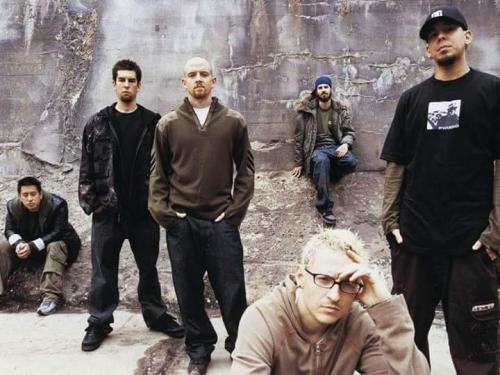

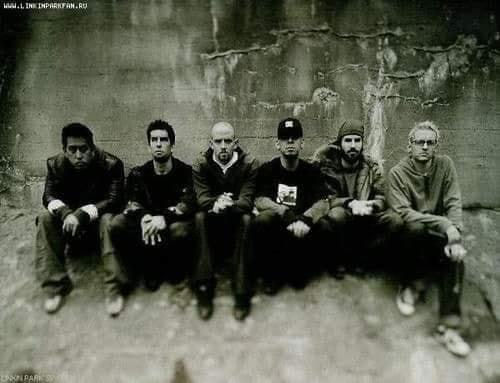
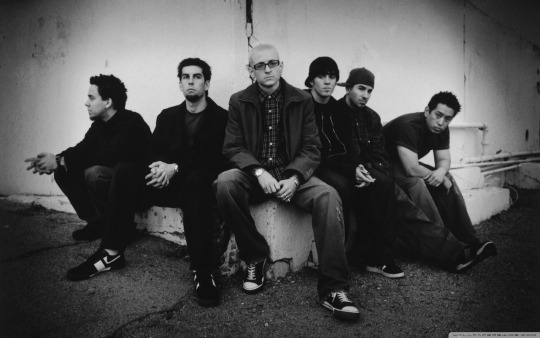
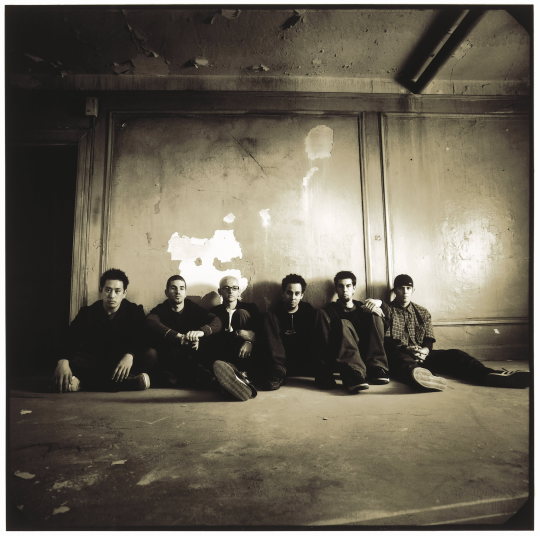
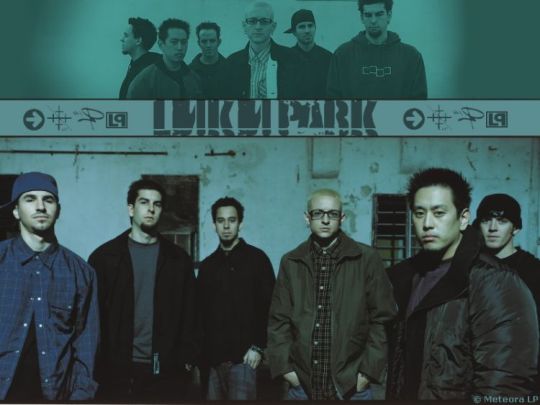
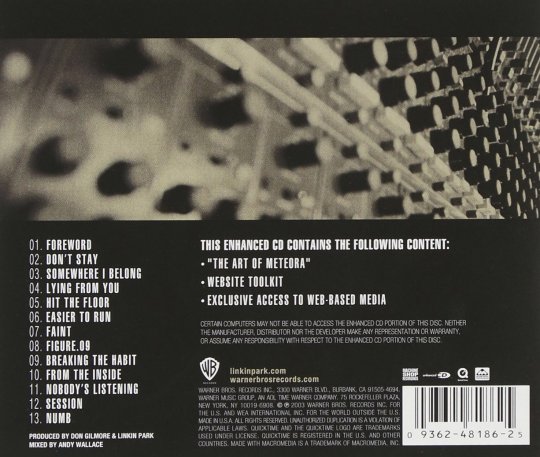
#linkin park#meteora#march 25#march 25th#3.25#3.25.03#3.25.2003#march 25 2003#march 25th 2003#2003#mike shinoda#brad delson#rob bourdon#joe hahn#dave phoenix farrell#chester bennington#2000s
10 notes
·
View notes
Link
2 notes
·
View notes